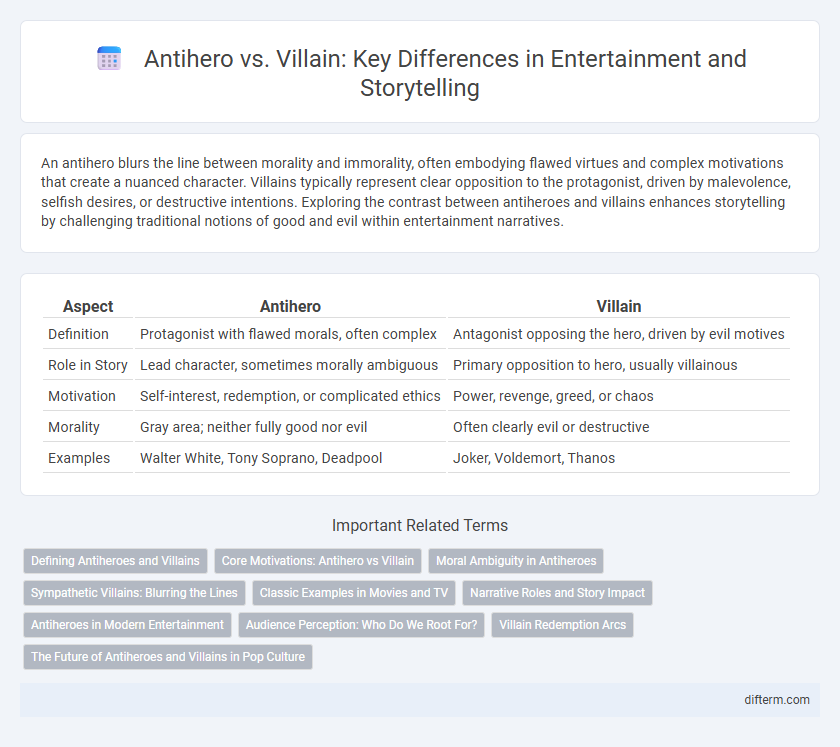An antihero blurs the line between morality and immorality, often embodying flawed virtues and complex motivations that create a nuanced character. Villains typically represent clear opposition to the protagonist, driven by malevolence, selfish desires, or destructive intentions. Exploring the contrast between antiheroes and villains enhances storytelling by challenging traditional notions of good and evil within entertainment narratives.
Table of Comparison
| Aspect | Antihero | Villain |
|---|---|---|
| Definition | Protagonist with flawed morals, often complex | Antagonist opposing the hero, driven by evil motives |
| Role in Story | Lead character, sometimes morally ambiguous | Primary opposition to hero, usually villainous |
| Motivation | Self-interest, redemption, or complicated ethics | Power, revenge, greed, or chaos |
| Morality | Gray area; neither fully good nor evil | Often clearly evil or destructive |
| Examples | Walter White, Tony Soprano, Deadpool | Joker, Voldemort, Thanos |
Defining Antiheroes and Villains
Antiheroes embody complex characters who lack traditional heroic qualities yet often garner audience empathy through flawed morality and internal conflict. Villains, in contrast, consistently pursue malicious goals, embodying clear opposition to protagonists with little regard for ethical boundaries. The nuanced portrayal of antiheroes challenges conventional narratives by blurring the lines between good and evil, while villains distinctly represent antagonistic forces within entertainment stories.
Core Motivations: Antihero vs Villain
Antiheroes are driven by complex, often conflicting motivations such as personal redemption, moral ambiguity, or survival, blurring the lines between right and wrong. Villains typically pursue self-serving goals like power, revenge, or chaos, exhibiting clear antagonistic intent. Understanding these core motivations reveals the nuanced psychological and ethical layers distinguishing antiheroes from villains in storytelling.
Moral Ambiguity in Antiheroes
Antiheroes embody moral ambiguity by displaying complex motivations and ethical conflicts, often blurring the lines between good and evil, unlike traditional villains who exhibit clear malevolence and destructive intent. Their flawed nature and relatable struggles allow audiences to explore nuanced perspectives on right and wrong, making them compelling and multifaceted characters in entertainment narratives. This moral gray area challenges viewers to question conventional morality and empathize with characters operating outside typical heroic standards.
Sympathetic Villains: Blurring the Lines
Sympathetic villains in entertainment challenge traditional narratives by blending traits typically associated with antiheroes, such as complex motivations and emotional depth. These characters often evoke audience empathy through backstories that reveal trauma or moral ambiguity, complicating the clear distinction between heroism and villainy. By highlighting their vulnerabilities and internal conflicts, storytellers create nuanced portrayals that blur the lines between antihero and villain, enriching the narrative landscape.
Classic Examples in Movies and TV
Classic examples of antiheroes in movies and TV include Tony Soprano from "The Sopranos" and Walter White from "Breaking Bad," characters who blend moral ambiguity with relatable motives. Villains like Darth Vader in "Star Wars" and Hannibal Lecter in "The Silence of the Lambs" embody clear malevolence and act as direct antagonists to heroes. The narrative complexity of antiheroes often challenges traditional hero-villain dichotomies, enriching storytelling in modern entertainment.
Narrative Roles and Story Impact
Antiheroes blur moral lines by embodying flawed protagonists whose complex motivations create nuanced narratives, often eliciting audience empathy despite questionable actions. Villains serve as clear antagonists, driving conflict through opposition to the hero's goals and embodying moral extremes that heighten dramatic tension. The interplay between antiheroes and villains enriches storytelling by challenging traditional heroism and expanding character depth, ultimately intensifying emotional engagement and plot complexity.
Antiheroes in Modern Entertainment
Antiheroes dominate modern entertainment by presenting complex characters who blur traditional moral lines, often displaying flawed, relatable traits that challenge the hero-villain binary. Series like "Breaking Bad" and "The Boys" have popularized protagonists who operate outside societal norms, attracting audiences with their nuanced motivations and internal conflicts. This shift reflects a growing appetite for stories that explore the darker, multifaceted aspects of human nature rather than clear-cut villainy.
Audience Perception: Who Do We Root For?
Audiences often root for antiheroes due to their complex motivations and moral ambiguity, which create relatable and psychologically rich characters. Villains typically embody clear antagonism and unethical behavior, making them less sympathetic but essential for driving conflict. The blurred lines in antiheroes challenge traditional hero-villain dynamics, engaging viewers in nuanced emotional and ethical debates.
Villain Redemption Arcs
Villain redemption arcs transform antagonists from mere adversaries into complex characters grappling with morality and change, enriching entertainment narratives. These arcs often explore themes of remorse, forgiveness, and the struggle for personal redemption, offering audiences a deeper emotional connection. By humanizing villains, stories challenge traditional black-and-white character roles, enhancing thematic depth and audience engagement.
The Future of Antiheroes and Villains in Pop Culture
The future of antiheroes and villains in pop culture reveals a shift toward more complex and morally ambiguous characters who captivate audiences with their depth and relatability. Streaming platforms and interactive media are expanding storytelling possibilities, allowing nuanced portrayals that blur the line between heroism and villainy. Emerging trends highlight antiheroes as central figures in narrative-driven content, reflecting contemporary societal questions about morality and identity.
antihero vs villain Infographic

 difterm.com
difterm.com